Abstract
The ability to sequentially learn from few examples and re-utilize previous knowledge is an important milestone on the path to artificial general intelligence. In this paper, we propose Teach Machine to Learn (TML), a few-shot learning model for hand-drawn multi-symbol sketch recognition. The model decomposes multi-symbol sketch into stroke primitives and then explains the observed sequences in a bayesian criterion. A Bidirectional Long Short Term Memory (BiLSTM) encoder is employed for stroke primitives encoding. Meanwhile, a probabilistic Hidden Markov Model (HMM) is constructed for complete sketch inference and recognition. The challenging task of hand-drawn multi-symbol sketch recognition is implemented on two public datasets. The comparative results indicate that the proposed method outperforms the currently booming image-based deep models in recognition accuracy. Furthermore, our method is capable to continuously learn new concepts even in one-shot. The codes are currently available in https://github.com/chongyupan/Teach-Machine-to-Learn.












Similar content being viewed by others
References
Silver D, Huang A, Maddison CJ, et al (2016) Mastering the game of Go with deep neural networks and tree search[J]. Nature 529(7587):484–489
Krizhevsky A, Sutskever I, Hinton GE, et al (2012) ImageNet classification with deep convolutional neural networks[J]. Neural Inform Process Syst 141(5):1097–1105
Nguyen A, Yosinski J, Clune J et al (2015) Deep neural networks are easily fooled: High confidence predictions for unrecognizable images[J]. Comput Vis Pattern Recogn, 427–436
Su J, Vargas DV, Sakurai K, et al (2019) One pixel attack for fooling deep neural networks[J]. IEEE Trans Evol Comput, 1–1
Tirkaz C, Yanikoglu B, Sezgin TM, et al (2012) Sketched symbol recognition with auto-completion[J]. Pattern Recogn 45(11):3926–3937
Lake BM, Salakhutdinov R, Tenenbaum JB, et al (2015) Human-level concept learning through probabilistic program induction[J]. Science 350(6266):1332–1338
Vinyals O, Blundell C, Lillicrap TP et al (2016) Matching networks for one shot learning[J]. Neural Inform Process Syst, 3637–3645
Aljundi R, Chakravarty P, Tuytelaars T et al (2017) Expert gate: lifelong learning with a network of experts[J]. Comput Vis Pattern Recogn, 7120–7129
Ruvolo P, Eaton E (2013) ELLA: an efficient lifelong learning algorithm[C]. In: International conference on machine learning, pp 507–515
George D, Lehrach W, Kansky K, et al (2017) A generative vision model that trains with high data efficiency and breaks text-based CAPTCHAs[J]. Science 358:6368
Holzinger A, Kickmeier-Rust M, Müller H (2019) KANDINSKY patterns as IQ-test for machine learning. In: International cross-domain conference for machine learning and knowledge extraction, lecture notes in computer science LNCS 11713. Springer, Canterbury, pp 1–14, DOI https://doi.org/10.1007/978-3-030-29726-8_1
Lecun Y, Bengio Y, Hinton GE, et al (2015) Deep learning[J]. Nature 521(7553):436–444
Olsen L, Samavati F, Sousa MC, et al (2009) Sketch-based modeling: a survey[J]. Comput Graph 33 (1):85–103
Eitz M, Hildebrand K, Boubekeur T, et al (2011) Sketch-based image retrieval: benchmark and bag-of-features descriptors[J]. IEEE Trans Vis Comput Graph 17(11):1624–1636
Hu R, Collomosse J (2013) A performance evaluation of gradient field HOG descriptor for sketch based image retrieval[J]. Comput Vis Image Underst 117(7):790–806
Forbus KD, Usher J, Chapman V et al (2003) Sketching for military courses of action diagrams[C]. Intelligent User Interfaces, 61–68. https://doi.org/10.1145/604045.604059
Hammond T, Logsdon D, Paulson B et al (2010) A sketch recognition system for recognizing free-hand course of action diagrams[C]. Innovative Applications of Artificial Intelligence
Paulson B, Hammond T (2008) PaleoSketch: accurate primitive sketch recognition and beautification[C]. Intelligent User Interfaces, 1–10
Fonseca MJ, Jorge JA (2000) Using fuzzy logic to recognize geometric shapes interactively[C]. In: IEEE International conference on fuzzy systems, pp 291–296
Sezgin TM, Stahovich TF, Davis R et al (2006) Sketch based interfaces: early processing for sketch understanding[C]. In: International conference on computer graphics and interactive techniques
Harding PR, Ellis T (2004) Recognizing hand gesture using Fourier descriptors[C]. In: International conference on pattern recognition, pp 286–289
Dalal N, Triggs B (2005) Histograms of oriented gradients for human detection[C]. Comput Vis Pattern Recogn, 886–893
Ouyang TY, Davis R (2009) A visual approach to sketched symbol recognition[C]. In: International joint conference on artificial intelligence, pp 1463–1468
Shechtman E, Irani M (2007) Matching Local Self-Similarities across images and videos[C]. Comput Vis Pattern Recogn, 1–8
Oltmans M (2007) Envisioning sketch recognition: a local feature based approach to recognizing informal sketches. Doctoral Dissertation, OAI: oai:dspace.mit.edu:1721.1/40318
Rosa MD (2014) New methods, techniques and applications for sketch recognition. Doctoral Dissertation, https://doi.org/10.14273/unisa-304
Schneider RG, Tuytelaars T (2014) Sketch classification and classification-driven analysis using Fisher vectors[J]. Int Conf Comput Graph Interact Techn, 33(6)
Tümen S, Acer ME, Sezgin TM (2010) Feature extraction and classifier combination for image-based sketch recognition[C]. Sketch Based Interfaces and Modeling, 63–70. https://doi.org/10.2312/SBM/SBM10/063-070
Li Y, Hospedales TM, Song Y, et al (2015) Free-hand sketch recognition by multi-kernel feature learning[J]. Comput Vis Image Underst, (137), 1–11
Ouyang TY (2012) Understanding freehand diagrams: combining appearance and context for multi-domain sketch recognition, Doctoral Dissertation
Sezgin TM, Davis R (2007) Sketch interpretation using multiscale models of temporal patterns[J]. IEEE Comput Graph Appl 27(1):28–37
Sezgin TM, Davis R (2005) HMM-based efficient sketch recognition[C]. Intell User Interfaces, 281–283
Ha D, Eck D (2018) A neural representation of sketch drawings[J]. International Conference on Learning Representations
Eitz M, Hays J, Alexa M et al (2012) How do humans sketch objects[J]. Int Conf Comput Graph Interact Techniques, 31(4)
Zou C, Yu Q, Du R et al (2018) SketchyScene: richly-annotated scene sketches[C]. Europ Conf Comput Vis, pp 438–454
Yu Q, Yang Y, Liu F, et al (2017) Sketch-a-net: a deep neural network that beats humans[J]. Int J Comput Vis 122(3):411–425
Li Y, Bu R, Sun M et al (2018) PointCNN: convolution on x-transformed points[C]. Neural Inform Process Syst, 820– 830
Sun Z, Wang C, Zhang L et al (2012) Free hand-drawn sketch segmentation[C]. European Conf Comput Vis, 626–639
Zhang J, Chen Y, Li L et al (2018) Context-based sketch classification[C]. Non Photorealistic Animation and Rendering
Hu C, Li D, Song Y, et al (2018) Sketch-a-classifier: sketch-based photo classifier generation[J]. arXiv: Computer Vision and Pattern Recognition
Verma VK, Mishra A, Mishra AK, et al (2019) Generative model for zero-shot sketch-based image retrieval[J]. arXiv: Computer Vision and Pattern Recognition
Song J, Pang K, Song Y et al (2018) Learning to sketch with shortcut cycle consistency[C]. Comput Vis Pattern Recogn, 801–810
Xu P, Huang Y, Yuan T, et al (2018) SketchMate: deep hashing for million-scale human sketch retrieval[C]. In: IEEE/CVF Conference on computer vision and pattern recognition, pp 8090–8098. https://doi.org/10.1109/CVPR.2018.00844
Lake BM, Salakhutdinov R, Gross J, et al (2011) One shot learning of simple visual concepts[J]. Cognit Sci 33:33
Girshick R, Donahue J, Darrell T et al (2014) Rich feature hierarchies for accurate object detection and semantic segmentation[J]. Comput Vis Pattern Recogn, 580–587
Redmon J, Divvala SK, Girshick R, et al (2016) You only look once: unified, real-time object detection[C]. Comput Vis Pattern Recogn, 779–788
Liu W, Anguelov D, Erhan D et al (2016) SSD: single shot multibox detector[J]. European Conf Comput Vis, 21–37
Lin T, Dollar P, Girshick R et al (2017) Feature pyramid networks for object detection[C]. Comput Vis Pattern Recogn, 936– 944
Sung F, Yang Y, Zhang L et al (2018) Learning to compare: relation network for few-shot learning[J]. Comput Vis Pattern Recogn, 1199–1208
Hassabis D, Kumaran D, Summerfield C, et al (2017) Neuroscience-inspired artificial intelligence[J]. Neuron 95(2):245–258
Acknowledgments
This work was supported by the equipment pre-research sharing technology project of China (No. 41412030301).
Author information
Authors and Affiliations
Corresponding author
Additional information
Publisher’s note
Springer Nature remains neutral with regard to jurisdictional claims in published maps and institutional affiliations.
Rights and permissions
About this article
Cite this article
Pan, C., Huang, J., Gong, J. et al. Teach machine to learn: hand-drawn multi-symbol sketch recognition in one-shot. Appl Intell 50, 2239–2251 (2020). https://doi.org/10.1007/s10489-019-01607-0
Published:
Issue Date:
DOI: https://doi.org/10.1007/s10489-019-01607-0




